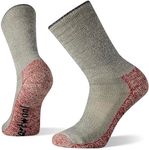Buying Guide for the Best Hiking Socks
Choosing the right hiking socks is crucial for ensuring comfort, preventing blisters, and keeping your feet dry and warm during your outdoor adventures. The right pair of socks can make a significant difference in your hiking experience. Here are some key specifications to consider when selecting hiking socks and how to navigate them to find the best fit for your needs.MaterialThe material of hiking socks is important because it affects breathability, moisture-wicking, and durability. Common materials include merino wool, synthetic fibers, and blends. Merino wool is known for its softness, moisture-wicking properties, and temperature regulation, making it ideal for various weather conditions. Synthetic fibers like polyester and nylon are durable and dry quickly, which is great for wet conditions. Blends combine the benefits of different materials. Choose merino wool for versatile use, synthetic for durability and quick drying, or blends for balanced performance.
CushioningCushioning refers to the amount of padding in the sock, which impacts comfort and protection. Light cushioning is suitable for warm weather and short hikes, providing minimal padding. Medium cushioning offers a balance of comfort and breathability, ideal for moderate hikes. Heavy cushioning provides maximum padding and warmth, perfect for long hikes and cold weather. Select light cushioning for short, warm-weather hikes, medium for moderate conditions, and heavy for extended, cold-weather hikes.
FitThe fit of hiking socks is crucial for preventing blisters and ensuring comfort. Socks should fit snugly without being too tight, and they should not bunch up or slide down. Look for socks with a contoured design that matches the shape of your foot and arch support for added comfort. Consider your shoe size and the thickness of the sock when choosing the right fit. A well-fitting sock will stay in place and provide consistent support throughout your hike.
HeightSock height determines how much of your leg is covered and protected. No-show and ankle socks are suitable for low-cut hiking shoes and warm weather, providing minimal coverage. Crew socks offer more coverage and protection, reaching up to the mid-calf, ideal for moderate conditions and higher-cut boots. Knee-high socks provide maximum coverage and warmth, perfect for cold weather and deep snow. Choose no-show or ankle socks for short, warm hikes, crew socks for moderate conditions, and knee-high socks for cold, snowy hikes.
Moisture-wickingMoisture-wicking properties help keep your feet dry by drawing sweat away from the skin and allowing it to evaporate. This is important for preventing blisters and maintaining comfort. Merino wool and synthetic fibers are known for their excellent moisture-wicking abilities. When selecting hiking socks, prioritize those with good moisture-wicking properties, especially for long hikes or warm weather conditions where your feet are likely to sweat more.
DurabilityDurability is important to ensure your socks can withstand the rigors of hiking and last for many trips. Look for reinforced areas such as the heel and toe, which are prone to wear and tear. Synthetic fibers like nylon and polyester are generally more durable than natural fibers. If you plan on frequent or long hikes, choose socks with reinforced areas and durable materials to ensure they last longer and provide consistent performance.
















